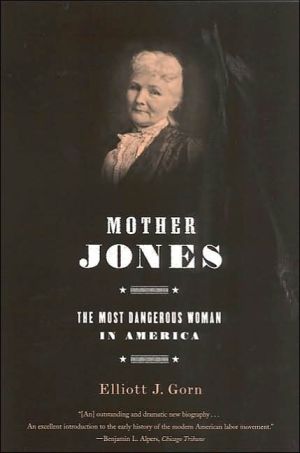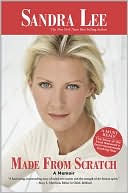Mother Jones
Her rallying cry was famous: "Pray for the dead and fight like hell for the living." A century ago, Mother Jones was a celebrated organizer and agitator, the very soul of the modern American labor movement. At coal strikes, steel strikes, railroad, textile, and brewery strikes, Mother Jones was always there, stirring the workers to action and enraging the powerful. In this first biography of "the most dangerous woman in America," Elliott J. Gorn proves why, in the words of Eugene V. Debs,...
Search in google:
Her rallying cry was famous: "Pray for the dead and fight like hell for the living." A century ago, Mother Jones was a celebrated organizer and agitator, the very soul of the modern American labor movement. At coal strikes, steel strikes, railroad, textile, and brewery strikes, Mother Jones was always there, stirring the workers to action and enraging the powerful. In this first biography of "the most dangerous woman in America," Elliott J. Gorn proves why, in the words of Eugene V. Debs, Mother Jones "has won her way into the hearts of the nation's toilers, and . . . will be lovingly remembered by their children and their children's children forever." David Roediger . . . a full, vivid, and meticulous account . . . Gorn shows how Mother Jones could keep hope . . . even as she led struggles . . ..
Introduction\ The life of Mother Jones is a faded memory, a half-forgotten story. A black-and-white image of an old woman or perhaps the words "Pray for the dead, and fight like hell for the living" are all that most people know of her. Yet during the early twentieth century, Mother Jones was one of the most famous women in America. Passionate speeches and dramatic street theater kept this fiery agitator in the news. For over a quarter century she held center stage, exposing disturbing truths about child labor, the poverty of working families, and the destruction of American freedoms. Her admirers called her labor's Joan of Arc and the miners' angel; enemies labeled her a dangerous radical — indeed, the most dangerous woman in America.\ Picture her, grandmotherly, sweet-faced, white-haired, swaying throngs of working-class people with her resonant oratory. Legend tells how she faced down gun-toting thugs and how she endured frequent imprisonment without fear. She cherished her image as a fighter. When introduced to a crowd as a great humanitarian once, she snapped, "Get it straight, I'm not a humanitarian, I'm a hell-raiser." She articulated for working men and women the belief that they had created the world with their own hands and that by right it belonged to them. She was a militant matriarch uniting the family of labor through her words and her raw physical courage. \ Although Mother Jones was most vividly associated with bitter mine wars, she also worked with railroad trolley-car, textile, brewery, garment, and steel workers. In an age of outrageous exploitation, her fight was wherever people organized for humane hours and decent pay. She was the Johnny Appleseed of American activists, giving speeches and organizing across the continent, sleeping in workers' cabins, boardinghouses, or the homes of friends. Asked to state her residence to a congressional committee, she declared, "I live in the United States, but I do not know exactly in what place, because I am always in the fight against oppression and wherever a fight is going on I have to jump there . . . so that really I have no particular residence." She added, "My address is like my shoes; it travels with me wherever I go." \ Her contemporaries marveled at her. "She is a wonder," the poet Carl Sandburg wrote of Mother Jones during World War I. "Close to 88 years old and her voice a singing voice; nobody else could give me a thrill just by saying in that slow, solemn, orotund way, 'The kaisers of this country are next, I tell ye.'" Clarence Darrow, America's greatest trial lawyer of the early twentieth century, wrote that "her deep convictions and fearless soul always drew her to seek the spot where the fight was hottest and the danger greatest." The feminist author Meridel Le Sueur was only fourteen years old when she first heard Mother Jones speak, but she never forgot it: "I felt engendered by the true mother, not the private mother of one family, but the emboldened and blazing defender of all her sons and daughters."\ At first glance, Mother Jones was not a likely candidate for such renown. An Irish immigrant who had survived famine, fire, plague, hard labor, and unspeakable loss, she was nearly as dispossessed as an American could be. She had ambition and talent, certainly, but those were no guarantee of success. How did she come to prominence? \ Her fame began when, toward the end of the nineteenth century, she transformed herself from Mary Jones into Mother Jones. Her new persona was a complex one, infused with overtones of Christian martyrdom and with the suffering of Mother Mary. Perhaps it is best to think of Mother Jones as a character performed by Mary Jones. She exaggerated her age, wore old-fashioned black dresses, and alluded often to her impending demise. By 1900, she had stopped referring to herself as Mary altogether and signed all of her letters "Mother." Soon laborers, union officials, even Presidents of the United States addressed her that way, and they became her "boys." \ The persona of Mother Jones freed Mary Jones. Most American women in the early twentieth century were expected to lead quiet, homebound lives for their families; few women found their way onto the public stage. Ironically, by making herself into the symbolic mother of the downtrodden, Mary Jones was able to go where she pleased and speak out on any issue that moved her. She defied social conventions and shattered the limits that confined her by embracing the very role that restricted most women. \ Her fame did not last. Eugene Debs, labor leader and Socialist Party candidate for President, recalled of his old friend, "She has won her way into the hearts of the nation's toilers, and her name is revered at the altars of their humble firesides and will be lovingly remembered by their children and their children's children forever." Debs was wrong; few grandchildren ever heard of her exploits. Mother Jones fell victim to what the English historian E. P. Thompson has called "the enormous condescension of posterity." \ My purpose in writing this book is to resist such amnesia. The early decades of the twentieth century were filled with dissent and conflict; radicals helped foster a creative dialogue in American society. During the years of her greatest visibility, from the turn of the century through the early 1920s, Mother Jones had one of the most unique and powerful voices in that dialogue. \ One hundred years after she first appeared in the news, almost a fifth of America's children live in poverty. They are the children of Mother Jones. Working families struggling for decent lives are her heirs, too. Indeed, all who raise their voices against social injustice and resist the easy complacency of our times are the sons and daughters of Mother Jones. \ Copyright © 2001 Elliot J. Gorn
\ From the Publisher"Imaginatively written and meticulously researched biography." —Elizabeth Sherman, The Boston Sunday Globe\ "Elliott Gorn's outstanding and dramatic new biography of Mother Jones reacquaints us with this extraordinary figure . . ." —Benjamin L. Alpers, Chicago Tribune\ "[A] lively, well-honed biography . . . Admirable." —David S. Reynolds, The New York Times Book Review\ \ \ \ \ \ New York Times Book ReviewA lively, well-honored biography. Gorn eloquently describes how Mother Jones worked within the code of conventional womanhood even as she opened new vistas in social reform....Admirable.\ \ \ Chicage TribuneElliott Gorn's outstanding and dramatic new biography of Mother Jones reacquaints us with this extraordinary figure [and] serves as an excellent introduction to the early history of the modern American labor movement.\ \ \ \ \ David S. Reynolds[A] lively, well-honed biography . . . Gorn eloquently describes how she worked within the code of conventional womanhood even as she opened new vistas in social reform. . . . Gorn does an admirable job of outlining her roots. . . .\ — New York Times Book Review\ \ \ \ \ Alice Kessler-Harris. . . beautifully rendered . . . It elegantly melds the legendary persona of Mary Harris Jones with an anguished history of labor struggle . . . Bravo!.\ \ \ \ \ David Roediger. . . a full, vivid, and meticulous account . . . Gorn shows how Mother Jones could keep hope . . . even as she led struggles . . ..\ \ \ \ \ Lawrence W. Levine. . . an imaginatively researched and beautifully written biography that deserves a wide audience..\ \ \ \ \ Publishers Weekly"Pray for the dead but fight like hell for the living" was the rallying cry that made Mother Jones (n e Mary Harris) one of the most famous union organizers and rabble-rousers. This highly engaging biography (the first since 1974) charts the life and work of one of the U.S.'s most important and captivating political figures. Born into an impoverished Irish family in County Cork in 1837, she immigrated to North America at age 15. After working as a seamstress and teacher, Harris married George Jones, a member of the International Iron Molders Union. At 30 she was widowed when her husband and four young children died in a yellow fever epidemic. Caught up in the mid-century's roiling labor and social upheavals, Jones threw herself into the political fray. Speaking tirelessly and effectively for the rights of workers and unionists--often using bold, flagrantly rhetorical and poetic metaphors--"Mother" Jones reached the height of her fame and influence by 1913 when, in her 70s, she campaigned for the United Mine Workers in West Virginia, where she was arrested for conspiracy to commit murder (she had urged striking minors to protect their families against the military brought in to break the strike). Gorn, professor of history at Purdue University, has successfully separated fact from myth (some of it promoted by Jones in her Autobiography), situating Jones's story within a wider cultural frame. Exploring issues from the complicated role of women in union organizing to the relationship of the Catholic Church to the working class and labor movements, he has produced a new and needed addition to contemporary labor and feminist literature. (Mar.) Copyright 2001 Cahners Business Information.\ \ \ \ \ Library JournalGorn (history, Purdue; A Brief History of American Sports) restores Mother Jones from leftist poster icon to imperfect flesh-and-blood radical. The author successfully fills in the gaps and puts Mother Jones's remarkable life into context. Before becoming a labor organizer and Socialist tribune, Jones witnessed the Irish potato famine, became an educated woman against heavy odds, and lost her children and husband to disease. In her efforts to unionize the working class, she pitted her courage, oratory, and organizing talents against the industrial robber barons and their government allies. Yet she deliberately clouded her past and often shaded the truth to promote her mythic status as "Mother" to the nation's toilers, and at times she was na ve and patronizing. This engaging biography recalls an almost forgotten American radicalism and reminds readers that the Gilded Age fa ade hid an industrial system built on exploited labor and poverty. Recommended for academic and larger public libraries. Duncan Stewart, State Historical Society of Iowa Lib., Iowa City Copyright 2001 Cahners Business Information.\ \ \ \ \ School Library JournalAdult/High School-From the Progressive Era forward, no one more forcefully or tirelessly championed the cause of low-wage earners than Mother Jones. Born Mary Harris in Ireland in 1837, she survived the potato famine, a yellow-fever epidemic that wiped out her entire family, and the Chicago Fire. Yet, as Gorn puts it, the "first half of her life prepared her for the task of becoming Mother Jones." Already in her mid- to late-50s by the time she became active in the nation's nascent and increasingly violent labor movement, Jones spent the next 30-odd years as a labor organizer and self-described hell-raiser. She exhorted her "boys" in coalfields and union halls from Colorado to West Virginia to demand the civil rights and human dignity that America promised to all. Modern teens may find it startling to learn that many of the issues Mother Jones and her colleagues faced-the wealth gap, a worker's right to a "living wage," the influence of Wall Street on Washington, and corporate monopolies-remain unresolved a century later. While sympathetic to his subject, Gorn neither minimizes Jones's faults nor veils the controversies that surrounded her, which included her selective memory, shortsightedness, and, ironically, her conventional views of women. This is a welcome adjunct to the study of the labor movement, women's history, and/or Progressivism. It is also an uplifting reading experience about a fiery, white-haired widow who excoriated the haves to the delight and benefit of the have-nots.-Dori DeSpain, Fairfax County Public Library, VA Copyright 2001 Cahners Business Information.\ \ \ \ \ BooknewsInspired by his life-long support for labor, Gorn (history, Purdue U.) presents a biography of Mary Jones (1837-1930), who as Mother Jones remains one of the best known and best loved organizers and agitators in the US. He recounts her rabble- rousing during strikes at coal mines, steel mills, railroads, textile factories, breweries, and other hot spots across the country. Annotation c. Book News, Inc., Portland, OR (booknews.com)\ \ \ \ \ Kirkus ReviewsA stimulating biography of the pugnacious labor organizer that sheds light on radical movements while questioning the myth-making machine that surrounds great figures. Gorn (The Manly Art, not reviewed) tells the story of two women: Mary Harris Jones and her nom de guerre, Mother Jones. Digging deep into news archives, journals, census files, and other sources, he finds truths about the life of the former that have been obscured by the self-created myth of the latter. Mary Harris was born in Ireland during the summer of 1837; Mother Jones claimed May Day, 1830, as her natal date. After emigrating to America, Mary Harris Jones lost her four children (and her husband) to yellow fever in 1867; Mother Jones proclaimed herself a mother to all workers. Through this juxtaposition, the reader sees what is, despite some unfulfilled promise and a fair share of lost battles, an American success story. An immigrant, a woman, an elderly widow, and a worker, she made her voice heard throughout her adopted land by dint of "nothing but courage, compassion and commitment," Gorn writes. Yet her legacy has been "blunted," he asserts, along with "memories of America's radical tradition." Once an "apostle of working-class militance," since her death in 1930 Mother Jones has been sanitized into a benevolent matriarch. Gorn never offers an entirely satisfactory answer to the question of how and why a middle-aged, widowed seamstress made her way onto labor's center stage at the end of the 19th century. He settles on cumulative experience as the key, arguing that personal tragedy and early exposure to radical thinking, combined with nearly half a century of witnessing poor people's struggles, "energized thelife of Mother Jones." Amid the current concerns over global labor exploitation, this is a timely, unromanticized reminder that human suffering has accompanied industrial change in the past, and that people fought to ameliorate it.\ \








